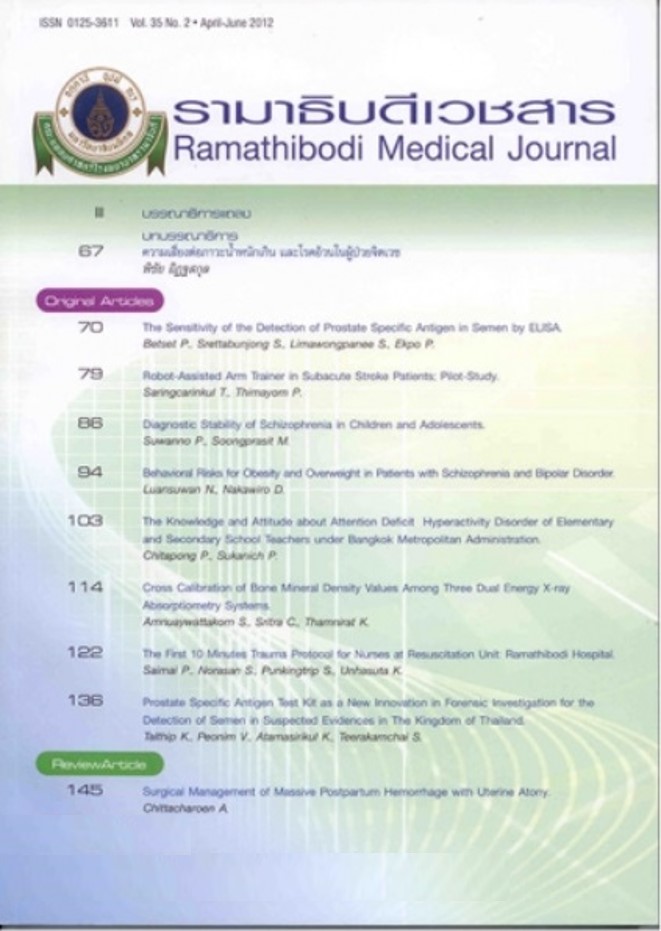Prostate Specific Antigen Test Kit as a New Innovation in Forensic Investigation for the Detection of Semen in Suspected Evidences in The Kingdom of Thailand
Main Article Content
Abstract
Introduction: Recently, routine forensic investigations of suspected evidences in rape cases are microscopic identification of the spermatozoa and acid phosphatase test foe detection of the seminal fluid.
Objective: Our article aimed to study the application of prostate specific antigen (PSA) test kit (PSA immunochromatographic assay) as a new method for the detection of semen in focus on the accuracy of test compared with the routinely used method, acid phosphatase test by using the sperm test as a gold standard method.
Methods: Five hundred vaginal swab and stain specimens from health care centers in Thailand submitted to Department of Pathology. Ramathibodi hospital were selected to this study. PSA immunochromatographic assay test and acid phosphatase test were performed in all specimens with compared to sperm test as a reference gold standard method. Statistical analysis was done to analyze the results.
Results: Our study results were correlated with many previous international studies that the PSA method has more accuracy than the acid phosphatase method in all parameters of test, including sensitivity, specificity, positive predictive value, and negative predictive value with statistical significance (p < 0.05).
Conclusion: We had confirmed that the PSA test kit would be an interesting innovation for forensic investigation, in sexual assault cases in The Kingdom of Thailand and all over the world.
Article Details
References
Brauner P, Gallili N. A condom--the critical link in a rape. J Forensic Sci. 1993;38(5):1233-6.
Brauner P. The evidence notwithstanding--a case report on a rape. J Forensic Sci. 1992;37(1):345-8.
Steinman G. Rapid spot tests for identifying suspected semen specimens. Forensic Sci Int. 1995;72(3):191-7. doi:10.1016/0379-0738(95)01703-L.
Simich JP, Morris SL, Klick RL, Rittenhouse-Diakun K. Validation of the use of a commercially available kit for the identification of prostate specific antigen (PSA) in semen stains. J Forensic Sci. 1999;44(6):1229-31.
Khaldi N, Miras A, Botti K, Benali L, Gromb S. Evaluation of three rapid detection methods for the forensic identification of seminal fluid in rape cases. J Forensic Sci. 2004;49(4):749-53.
Hochmeister MN, Budowle B, Rudin O, Gehrig C, Borer U, Thali M, et al. Evaluation of prostate-specific antigen (PSA) membrane test assays for the forensic identification of seminal fluid. J Forensic Sci. 1999;44(5):1057-60.
Laux DL. Tambasco AJ, Benzinger EA. Forensic Detection of Semen II. Comparison of the Abacus Diagnostics OneStep ABA card p30 Test and the SERATEC PSA Semiquant Kit for the Determination of the Presence of Semen in Forensic Cases. Available from: https://www.semanticscholar.org/paper/Forensic-Detection-of-Semen-II-Laux-Tambasco/b6e1e08e4a0096191a39498d34d4d0e371a6c999. Published 2003.
Laux DL, Custis SE. Forensic Detection of Semen III. Detection of PSA Using Membrane Based Tests : Sensitivity Issues with Regards to the Presence of PSA in Other Body Fluids. Available from: https://www.semanticscholar.org/paper/Forensic-Detection-of-Semen-III-.-Detection-of-PSA-Laux-Custis/0deed4e986ffbdc3b6e54e1a663c3ccf347e1c36. Published 2004.
Hooft PJ, van de Voorde HP. Interference of body products, food and products from daily life with the modified zinc test and the acid phosphatase test. Forensic Sci Int. 1994;66(3):187-96. doi:10.1016/0379-0738(94)90343-3.
Sutton JG, Bosley C, Rands A. The detection by enzyme linked immunosorbent assay of P30 and 19-OH prostaglandin F1/F2, in the presence of a range of possible contaminants. Sci Justice. 1998;38(3):157-64. doi:10.1016/S1355-0306(98)72100-8.
Macaluso M, Lawson L, Akers R, Valappil T, Hammond K, Blackwell R, et al. Prostate-specific antigen in vaginal fluid as a biologic marker of condom failure. Contraception. 1999;59(3):195-201. doi:10.1016/S0010-7824(99)00013-X.
Levine B, Titus JM, Moore K, Fowler D. Use of prostate specific antigen in the identification of semen in postmortem cases. Am J Forensic Med Pathol. 2004;25(4):288-90. doi:10.1097/01.paf.0000136640.06642.f8.
Peonim V, Chirachariyavej T, Atamasirikul K, Talthip J. Comparable between rapid one step immunochromatographic assay and ELISA in the detection of prostate specific antigen in vaginal specimens of raped women. J Med Assoc Thai. 2007;90(12):2624-9.
Maher J, Vintiner S, Elliot D, Melia L. Evaluation of the BioSign PSA membrane test for the identification of semen stains in forensic casework. N Z Med J. 2002;115(1147):48-9.
Sato I, Kojima K, Yamasaki T, Yoshida K, Yoshiike M, Takano S, et al. Rapid detection of semenogelin by one-step immunochromatographic assay for semen identification. J Immunol Methods. 2004;287(1-2):137-45. doi:10.1016/j.jim.2004.01.017.
Yokota M, Mitani T, Tsujita H, Kobayashi T, Higuchi T, Akane A, et al. Evaluation of prostate-specific antigen (PSA) membrane test for forensic examination of semen. Leg Med (Tokyo). 2001 ;3(3):171-6. doi:10.1016/S1344-6223(01)00031-1.
